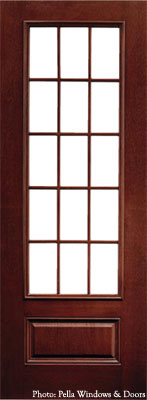 New homes have a big advantage over existing homes when it comes to energy efficiency. None of the old materials or problems get in the way when building a home from scratch.
New homes have a big advantage over existing homes when it comes to energy efficiency. None of the old materials or problems get in the way when building a home from scratch. The built-in savings can be as simple as creating a landscape design that reduces watering needs and high upkeep, or as expensive as super-insulation. In between are several other easy-to-implement ideas that could and should be built into every home plan.
1. Quality windows and doors make a huge difference. Poor windows can be massive energy wasters. Find Energy-Star rated windows with Low-E glass.
2. Large overhangs keep the summer sun from pouring in through the windows and protect your home from the elements.
3. Passive solar heat is free and allows the low winter sun (on the south-facing side of the house) to warm your home through southern windows.
4. Foundations are more energy efficient when they are poured with insulated concrete forms. Un-insulated basements can waste 30 percent of your energy dollars.
5. Air tightness vs. infiltration. Lousy insulation and poor air sealing can double your energy bills.
6. Ventilation is important, especially in great rooms.Keep sunlit rooms well ventilated to prevent overheating and to create even temperatures. Operable windows and ceiling fans can help.

7. Energy Star appliances, furnaces, windows, lighting, home sealants and roofing products are rated by the U. S. Environmental Protection Agency as energy savers.
8. Properly sized furnaces run at a steady rate, while oversized furnaces (a common problem) cycle on and off and waste energy.
9. Window coverings and shades provide added insulation, especially at night.
10. Most of your heated or cooled air will escape through the ceiling or attic, so insulate above, or build your roof with structural insulated panels (SIPs).
11. Glass fireplace doors and a heater/ blower insert optimize the heat generated by the fire.
12. On-demand tankless water heaters keep energy costs down by not having to keep 40 gallons of water heated day and night, and take up considerably less room than traditional models.
13. Fluorescent light bulbs use 50-75 percent less energy than incandescent bulbs and last up to 10 times longer. LED lights are even better.
14. Gaps around windows, doors and fixtures cause air infiltration, so fix them with caulk to save wasted energy.
15. Several thermostats controlling individual heating and cooling zones throughout your home save money and keep you comfortable. Programmable thermostats controlling those zones are even better.
Looking for energy-efficient gardening tips? Learn how to have a greener lawn.











